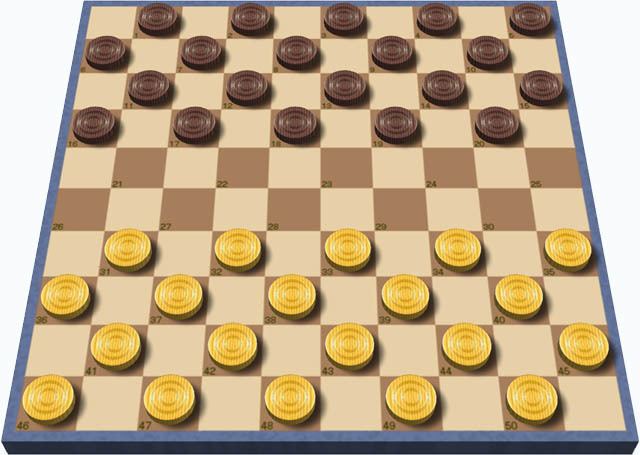Players 2 Random chance None | Setup time < 1 minute | |
 | ||
Genre(s) Board gameAbstract strategy game Synonym(s) Polish draughtsInternational checkers10×10 draughts10×10 checkers | ||
International draughts (also called Polish draughts or international checkers) is a strategy board game for two players, one of the variants of draughts. The gameboard comprises 10×10 squares in alternating dark and light colours, of which only the 50 dark squares are used. Each player has 20 pieces, light for one player and dark for the other, at opposite sides of the board. In conventional diagrams the board is displayed with the light pieces at the bottom; in this orientation the lower-left corner square must be dark.
Contents
Rules
The general rule is that all moves and captures are made diagonally. All references to squares refer to the dark squares only. The main differences from English draughts are: the size of the board (10×10), pieces can also capture backward (not only forward), the long-range moving and capturing capability of kings, and the requirement that the maximum number of men be captured whenever a player has capturing options.
Starting position
Moves and captures
Crowning
Winning and draws
These are extra rules accommodated in some tournaments and may vary:
Notation
Each of the fifty dark squares has a number (1 through 50). Number 46 is at the left corner seen from the player with the light pieces. Number 5 is at the left corner seen from the player with the dark pieces.
Sport
The first world championship was held in international draughts in 1894. It was won by Frenchman Isidore Weiss, who held the title for eighteen years. Then for nearly sixty years, the title was held by representatives from either France or the Netherlands, including Herman Hoogland, Stanislas Bizot, Marius Fabre, Ben Springer, Maurice Raichenbach, Pierre Ghestem, and Piet Roozenburg. In 1956 the hegemony of the French and the Dutch was broken: the champion was Canadian Marcel Deslauriers. In 1958, the USSR's Iser Kuperman became the world champion, beginning the era of Soviet victories domination in international draughts.
The official status of the world championships are held under the auspices of the World Draughts Federation (FMJD) since 1948. In 1998, the first World Championship was held in the format of the blitz. The first Women's World Championship was held in 1973. The first women's champion was Elena Mikhailovskaya from Soviet Union. A World Junior Championship has been contested since 1971; the first winner was Nicholay Mischansky.
In addition to the World Championships, there is also a European Championships since 1965 (men) and 2000 (women).
The World Draughts Federation maintains a ranking. As of July 2015 the men's list is headed by Alexander Shvartsman from Russia, and the women's list is headed by Zoja Golubeva from Latvia.
Computers
Computer draughts programs have been improving every year. Programmers wrote the first draughts programs in the mid 1970s. The first computer draughts tournament was in 1987. In 1993, computer draughts program Truus ranked about 40th in the world. In 2003 computer Draughts program Buggy beat world number 8 Samb. In 2005, the 10-time world champion and 2005 World champion, Alexei Chizhov, commented about computers. Chizhov said he could not beat the computer, but he also would not lose to the computer. In 2010, the 9 piece endgame database was built.
Schwarzman beat Maximus (2012)
Alexander Schwarzman beat computer program Maximus on April 14, 2012. Schwarzman won game 2 in the 6 game match. The other 5 games were draws. Schwarzman was world champion in 1998, 2007 and 2009. Jan-Jaap van Horssen of the Netherlands wrote Maximus. Maximus used a six piece endgame database. The computer was an Intel core i7-3930K at 3.2 GHz 32 gigabytes memory, a 6-core with hyperthreading. The average search depth was 24.5 ply. The average number of moves evaluated per second was 23,357,000. The average search time was 3 minutes and 52.98 seconds.
List of top international draughts programs
Some older well known programs are:
